Corporate Identity and Veil Lifting: Prest v Petrodel Resources Ltd
VerifiedAdded on 2020/07/23
|11
|3548
|347
Report
AI Summary
This report provides an in-depth analysis of corporate identity and the concept of veil lifting in corporate law. It begins by defining corporate identity and separate legal personality, emphasizing the landmark case of Salomon v Salomon and its significance in establishing the principle of limited liability. The report then explores the exceptions to this principle, focusing on the circumstances under which courts may 'pierce the corporate veil'. A detailed examination of the case of Prest v Petrodel Resources Ltd is presented, highlighting the Supreme Court's clarification on when veil piercing is appropriate, particularly in situations involving the evasion of legal obligations. The report differentiates between the principles of concealment and evasion, as well as the conditions under which veil lifting is considered. Furthermore, the report also addresses the statutory and judicial interpretations of veil lifting, including the fraud assumption and the exceptions to the separate entity concept. The report concludes by discussing the implications of these legal principles and their application in various corporate scenarios.

Report
Paraphrase This Document
Need a fresh take? Get an instant paraphrase of this document with our AI Paraphraser

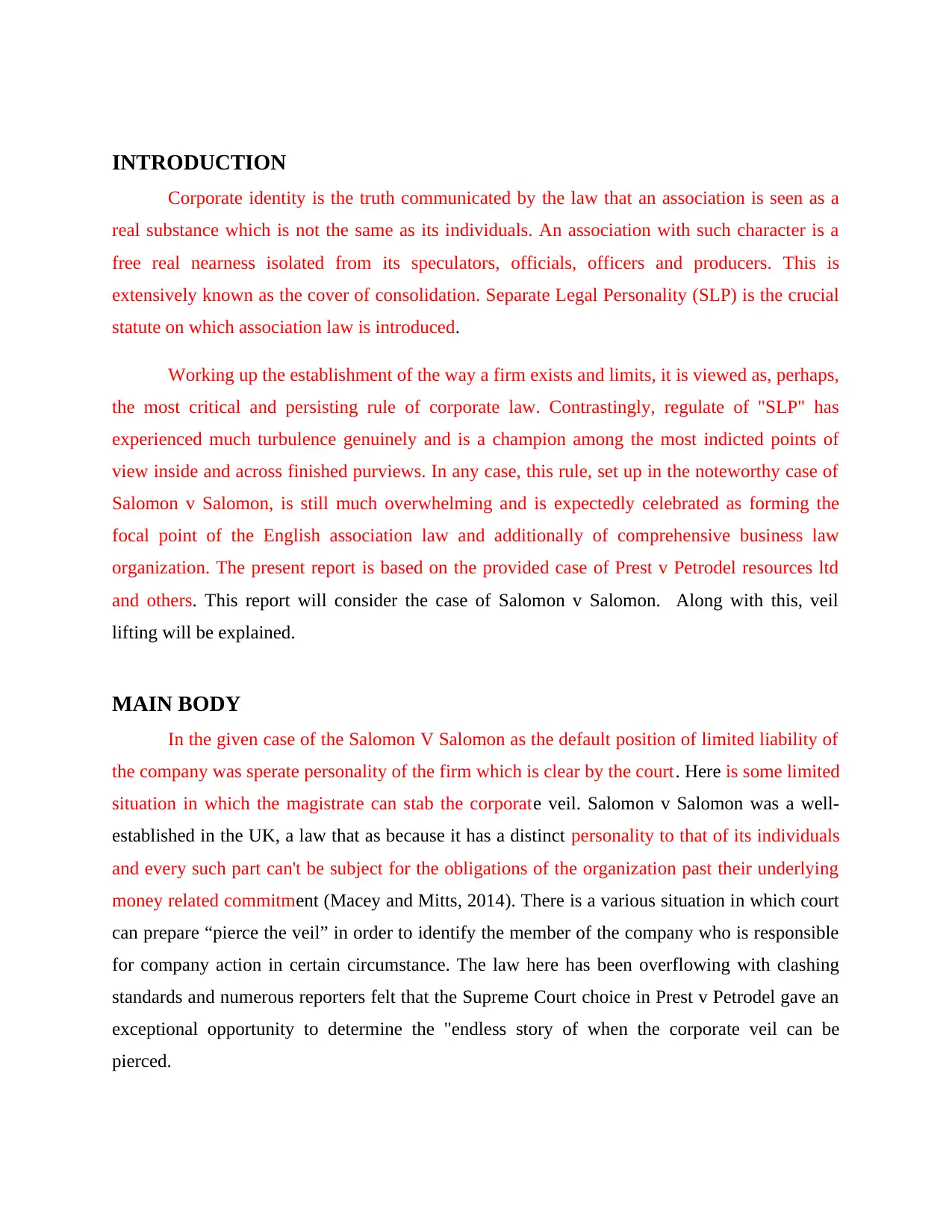
INTRODUCTION
Corporate identity is the truth communicated by the law that an association is seen as a
real substance which is not the same as its individuals. An association with such character is a
free real nearness isolated from its speculators, officials, officers and producers. This is
extensively known as the cover of consolidation. Separate Legal Personality (SLP) is the crucial
statute on which association law is introduced.
Working up the establishment of the way a firm exists and limits, it is viewed as, perhaps,
the most critical and persisting rule of corporate law. Contrastingly, regulate of "SLP" has
experienced much turbulence genuinely and is a champion among the most indicted points of
view inside and across finished purviews. In any case, this rule, set up in the noteworthy case of
Salomon v Salomon, is still much overwhelming and is expectedly celebrated as forming the
focal point of the English association law and additionally of comprehensive business law
organization. The present report is based on the provided case of Prest v Petrodel resources ltd
and others. This report will consider the case of Salomon v Salomon. Along with this, veil
lifting will be explained.
MAIN BODY
In the given case of the Salomon V Salomon as the default position of limited liability of
the company was sperate personality of the firm which is clear by the court. Here is some limited
situation in which the magistrate can stab the corporate veil. Salomon v Salomon was a well-
established in the UK, a law that as because it has a distinct personality to that of its individuals
and every such part can't be subject for the obligations of the organization past their underlying
money related commitment (Macey and Mitts, 2014). There is a various situation in which court
can prepare “pierce the veil” in order to identify the member of the company who is responsible
for company action in certain circumstance. The law here has been overflowing with clashing
standards and numerous reporters felt that the Supreme Court choice in Prest v Petrodel gave an
exceptional opportunity to determine the "endless story of when the corporate veil can be
pierced.
Corporate identity is the truth communicated by the law that an association is seen as a
real substance which is not the same as its individuals. An association with such character is a
free real nearness isolated from its speculators, officials, officers and producers. This is
extensively known as the cover of consolidation. Separate Legal Personality (SLP) is the crucial
statute on which association law is introduced.
Working up the establishment of the way a firm exists and limits, it is viewed as, perhaps,
the most critical and persisting rule of corporate law. Contrastingly, regulate of "SLP" has
experienced much turbulence genuinely and is a champion among the most indicted points of
view inside and across finished purviews. In any case, this rule, set up in the noteworthy case of
Salomon v Salomon, is still much overwhelming and is expectedly celebrated as forming the
focal point of the English association law and additionally of comprehensive business law
organization. The present report is based on the provided case of Prest v Petrodel resources ltd
and others. This report will consider the case of Salomon v Salomon. Along with this, veil
lifting will be explained.
MAIN BODY
In the given case of the Salomon V Salomon as the default position of limited liability of
the company was sperate personality of the firm which is clear by the court. Here is some limited
situation in which the magistrate can stab the corporate veil. Salomon v Salomon was a well-
established in the UK, a law that as because it has a distinct personality to that of its individuals
and every such part can't be subject for the obligations of the organization past their underlying
money related commitment (Macey and Mitts, 2014). There is a various situation in which court
can prepare “pierce the veil” in order to identify the member of the company who is responsible
for company action in certain circumstance. The law here has been overflowing with clashing
standards and numerous reporters felt that the Supreme Court choice in Prest v Petrodel gave an
exceptional opportunity to determine the "endless story of when the corporate veil can be
pierced.
⊘ This is a preview!⊘
Do you want full access?
Subscribe today to unlock all pages.

Trusted by 1+ million students worldwide
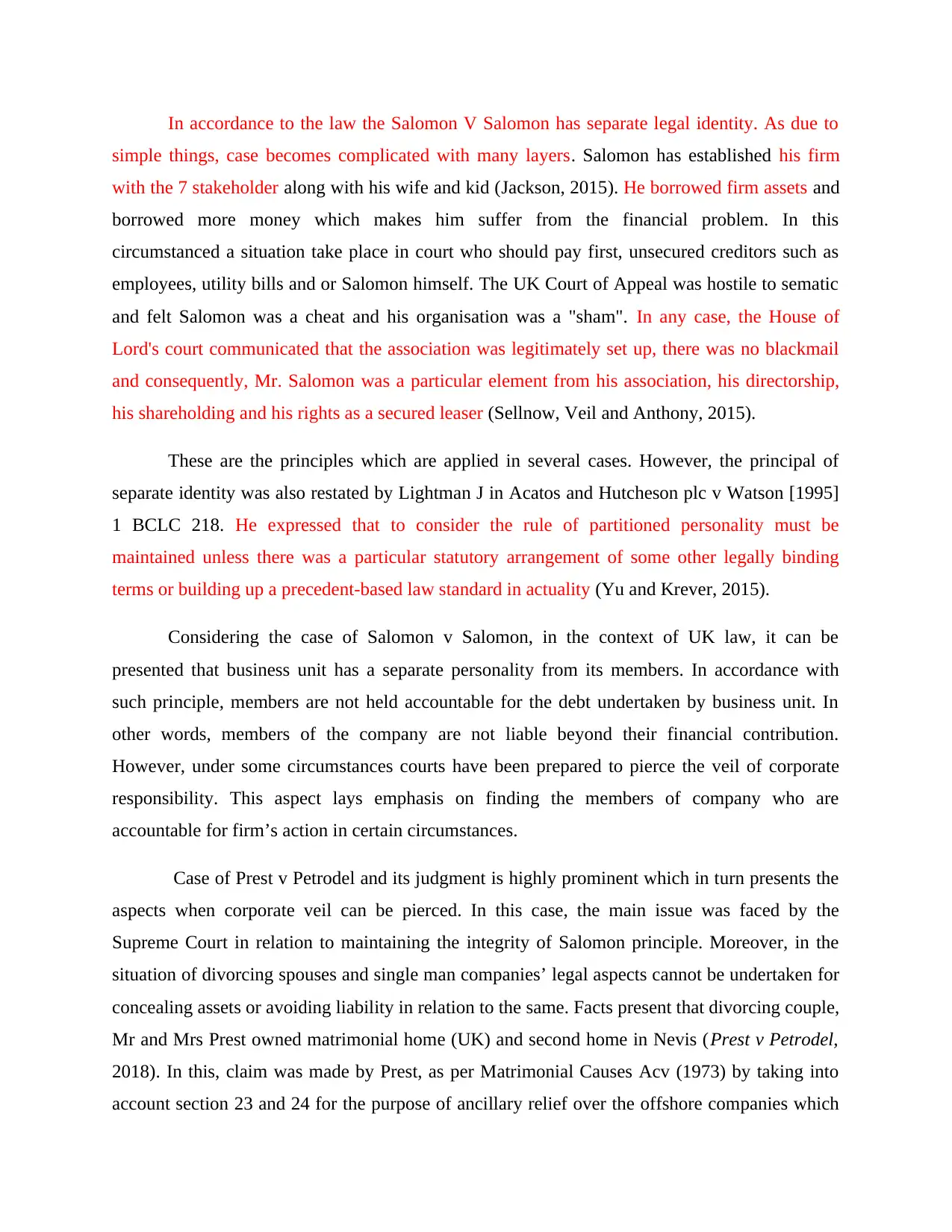
In accordance to the law the Salomon V Salomon has separate legal identity. As due to
simple things, case becomes complicated with many layers. Salomon has established his firm
with the 7 stakeholder along with his wife and kid (Jackson, 2015). He borrowed firm assets and
borrowed more money which makes him suffer from the financial problem. In this
circumstanced a situation take place in court who should pay first, unsecured creditors such as
employees, utility bills and or Salomon himself. The UK Court of Appeal was hostile to sematic
and felt Salomon was a cheat and his organisation was a "sham". In any case, the House of
Lord's court communicated that the association was legitimately set up, there was no blackmail
and consequently, Mr. Salomon was a particular element from his association, his directorship,
his shareholding and his rights as a secured leaser (Sellnow, Veil and Anthony, 2015).
These are the principles which are applied in several cases. However, the principal of
separate identity was also restated by Lightman J in Acatos and Hutcheson plc v Watson [1995]
1 BCLC 218. He expressed that to consider the rule of partitioned personality must be
maintained unless there was a particular statutory arrangement of some other legally binding
terms or building up a precedent-based law standard in actuality (Yu and Krever, 2015).
Considering the case of Salomon v Salomon, in the context of UK law, it can be
presented that business unit has a separate personality from its members. In accordance with
such principle, members are not held accountable for the debt undertaken by business unit. In
other words, members of the company are not liable beyond their financial contribution.
However, under some circumstances courts have been prepared to pierce the veil of corporate
responsibility. This aspect lays emphasis on finding the members of company who are
accountable for firm’s action in certain circumstances.
Case of Prest v Petrodel and its judgment is highly prominent which in turn presents the
aspects when corporate veil can be pierced. In this case, the main issue was faced by the
Supreme Court in relation to maintaining the integrity of Salomon principle. Moreover, in the
situation of divorcing spouses and single man companies’ legal aspects cannot be undertaken for
concealing assets or avoiding liability in relation to the same. Facts present that divorcing couple,
Mr and Mrs Prest owned matrimonial home (UK) and second home in Nevis (Prest v Petrodel,
2018). In this, claim was made by Prest, as per Matrimonial Causes Acv (1973) by taking into
account section 23 and 24 for the purpose of ancillary relief over the offshore companies which
simple things, case becomes complicated with many layers. Salomon has established his firm
with the 7 stakeholder along with his wife and kid (Jackson, 2015). He borrowed firm assets and
borrowed more money which makes him suffer from the financial problem. In this
circumstanced a situation take place in court who should pay first, unsecured creditors such as
employees, utility bills and or Salomon himself. The UK Court of Appeal was hostile to sematic
and felt Salomon was a cheat and his organisation was a "sham". In any case, the House of
Lord's court communicated that the association was legitimately set up, there was no blackmail
and consequently, Mr. Salomon was a particular element from his association, his directorship,
his shareholding and his rights as a secured leaser (Sellnow, Veil and Anthony, 2015).
These are the principles which are applied in several cases. However, the principal of
separate identity was also restated by Lightman J in Acatos and Hutcheson plc v Watson [1995]
1 BCLC 218. He expressed that to consider the rule of partitioned personality must be
maintained unless there was a particular statutory arrangement of some other legally binding
terms or building up a precedent-based law standard in actuality (Yu and Krever, 2015).
Considering the case of Salomon v Salomon, in the context of UK law, it can be
presented that business unit has a separate personality from its members. In accordance with
such principle, members are not held accountable for the debt undertaken by business unit. In
other words, members of the company are not liable beyond their financial contribution.
However, under some circumstances courts have been prepared to pierce the veil of corporate
responsibility. This aspect lays emphasis on finding the members of company who are
accountable for firm’s action in certain circumstances.
Case of Prest v Petrodel and its judgment is highly prominent which in turn presents the
aspects when corporate veil can be pierced. In this case, the main issue was faced by the
Supreme Court in relation to maintaining the integrity of Salomon principle. Moreover, in the
situation of divorcing spouses and single man companies’ legal aspects cannot be undertaken for
concealing assets or avoiding liability in relation to the same. Facts present that divorcing couple,
Mr and Mrs Prest owned matrimonial home (UK) and second home in Nevis (Prest v Petrodel,
2018). In this, claim was made by Prest, as per Matrimonial Causes Acv (1973) by taking into
account section 23 and 24 for the purpose of ancillary relief over the offshore companies which
Paraphrase This Document
Need a fresh take? Get an instant paraphrase of this document with our AI Paraphraser
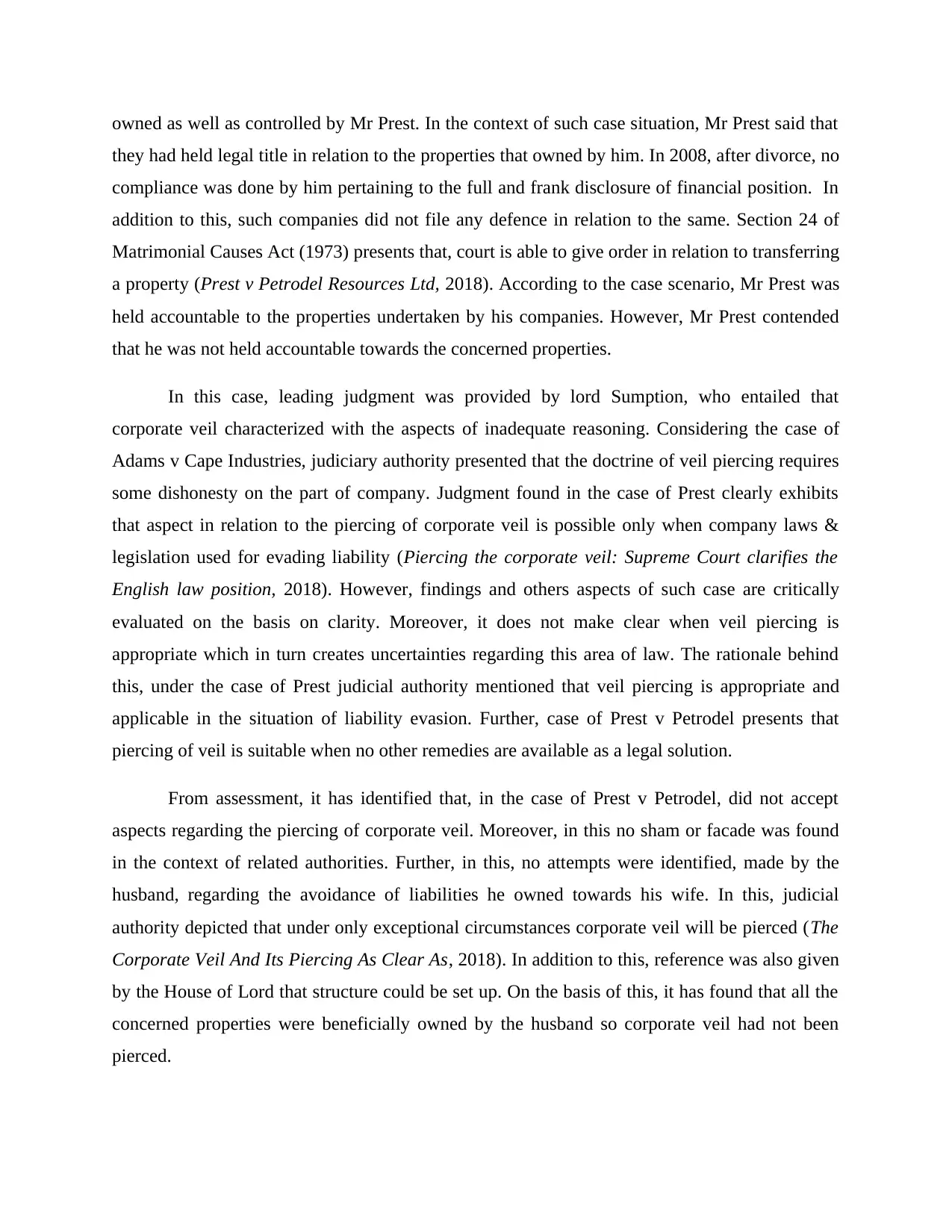
owned as well as controlled by Mr Prest. In the context of such case situation, Mr Prest said that
they had held legal title in relation to the properties that owned by him. In 2008, after divorce, no
compliance was done by him pertaining to the full and frank disclosure of financial position. In
addition to this, such companies did not file any defence in relation to the same. Section 24 of
Matrimonial Causes Act (1973) presents that, court is able to give order in relation to transferring
a property (Prest v Petrodel Resources Ltd, 2018). According to the case scenario, Mr Prest was
held accountable to the properties undertaken by his companies. However, Mr Prest contended
that he was not held accountable towards the concerned properties.
In this case, leading judgment was provided by lord Sumption, who entailed that
corporate veil characterized with the aspects of inadequate reasoning. Considering the case of
Adams v Cape Industries, judiciary authority presented that the doctrine of veil piercing requires
some dishonesty on the part of company. Judgment found in the case of Prest clearly exhibits
that aspect in relation to the piercing of corporate veil is possible only when company laws &
legislation used for evading liability (Piercing the corporate veil: Supreme Court clarifies the
English law position, 2018). However, findings and others aspects of such case are critically
evaluated on the basis on clarity. Moreover, it does not make clear when veil piercing is
appropriate which in turn creates uncertainties regarding this area of law. The rationale behind
this, under the case of Prest judicial authority mentioned that veil piercing is appropriate and
applicable in the situation of liability evasion. Further, case of Prest v Petrodel presents that
piercing of veil is suitable when no other remedies are available as a legal solution.
From assessment, it has identified that, in the case of Prest v Petrodel, did not accept
aspects regarding the piercing of corporate veil. Moreover, in this no sham or facade was found
in the context of related authorities. Further, in this, no attempts were identified, made by the
husband, regarding the avoidance of liabilities he owned towards his wife. In this, judicial
authority depicted that under only exceptional circumstances corporate veil will be pierced (The
Corporate Veil And Its Piercing As Clear As, 2018). In addition to this, reference was also given
by the House of Lord that structure could be set up. On the basis of this, it has found that all the
concerned properties were beneficially owned by the husband so corporate veil had not been
pierced.
they had held legal title in relation to the properties that owned by him. In 2008, after divorce, no
compliance was done by him pertaining to the full and frank disclosure of financial position. In
addition to this, such companies did not file any defence in relation to the same. Section 24 of
Matrimonial Causes Act (1973) presents that, court is able to give order in relation to transferring
a property (Prest v Petrodel Resources Ltd, 2018). According to the case scenario, Mr Prest was
held accountable to the properties undertaken by his companies. However, Mr Prest contended
that he was not held accountable towards the concerned properties.
In this case, leading judgment was provided by lord Sumption, who entailed that
corporate veil characterized with the aspects of inadequate reasoning. Considering the case of
Adams v Cape Industries, judiciary authority presented that the doctrine of veil piercing requires
some dishonesty on the part of company. Judgment found in the case of Prest clearly exhibits
that aspect in relation to the piercing of corporate veil is possible only when company laws &
legislation used for evading liability (Piercing the corporate veil: Supreme Court clarifies the
English law position, 2018). However, findings and others aspects of such case are critically
evaluated on the basis on clarity. Moreover, it does not make clear when veil piercing is
appropriate which in turn creates uncertainties regarding this area of law. The rationale behind
this, under the case of Prest judicial authority mentioned that veil piercing is appropriate and
applicable in the situation of liability evasion. Further, case of Prest v Petrodel presents that
piercing of veil is suitable when no other remedies are available as a legal solution.
From assessment, it has identified that, in the case of Prest v Petrodel, did not accept
aspects regarding the piercing of corporate veil. Moreover, in this no sham or facade was found
in the context of related authorities. Further, in this, no attempts were identified, made by the
husband, regarding the avoidance of liabilities he owned towards his wife. In this, judicial
authority depicted that under only exceptional circumstances corporate veil will be pierced (The
Corporate Veil And Its Piercing As Clear As, 2018). In addition to this, reference was also given
by the House of Lord that structure could be set up. On the basis of this, it has found that all the
concerned properties were beneficially owned by the husband so corporate veil had not been
pierced.
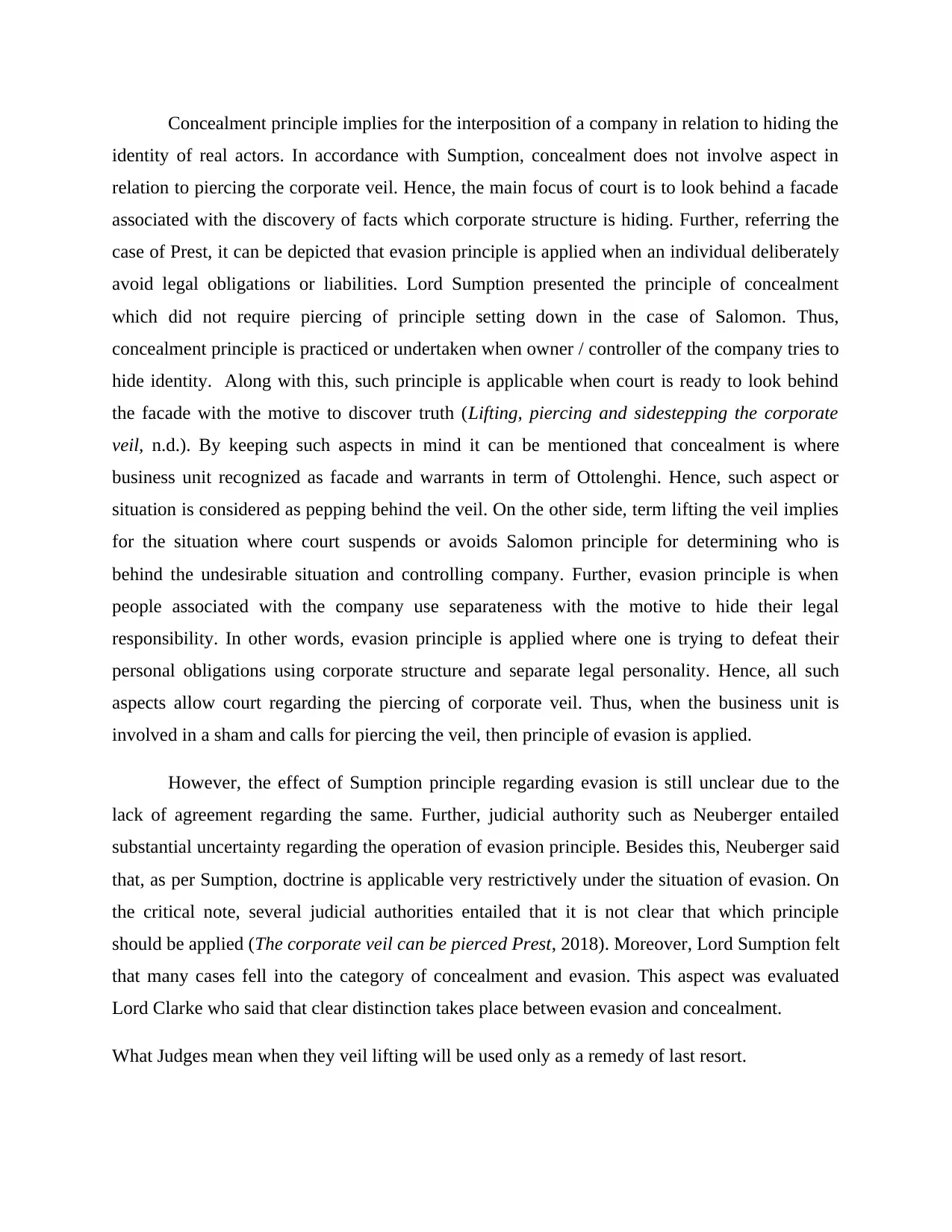
Concealment principle implies for the interposition of a company in relation to hiding the
identity of real actors. In accordance with Sumption, concealment does not involve aspect in
relation to piercing the corporate veil. Hence, the main focus of court is to look behind a facade
associated with the discovery of facts which corporate structure is hiding. Further, referring the
case of Prest, it can be depicted that evasion principle is applied when an individual deliberately
avoid legal obligations or liabilities. Lord Sumption presented the principle of concealment
which did not require piercing of principle setting down in the case of Salomon. Thus,
concealment principle is practiced or undertaken when owner / controller of the company tries to
hide identity. Along with this, such principle is applicable when court is ready to look behind
the facade with the motive to discover truth (Lifting, piercing and sidestepping the corporate
veil, n.d.). By keeping such aspects in mind it can be mentioned that concealment is where
business unit recognized as facade and warrants in term of Ottolenghi. Hence, such aspect or
situation is considered as pepping behind the veil. On the other side, term lifting the veil implies
for the situation where court suspends or avoids Salomon principle for determining who is
behind the undesirable situation and controlling company. Further, evasion principle is when
people associated with the company use separateness with the motive to hide their legal
responsibility. In other words, evasion principle is applied where one is trying to defeat their
personal obligations using corporate structure and separate legal personality. Hence, all such
aspects allow court regarding the piercing of corporate veil. Thus, when the business unit is
involved in a sham and calls for piercing the veil, then principle of evasion is applied.
However, the effect of Sumption principle regarding evasion is still unclear due to the
lack of agreement regarding the same. Further, judicial authority such as Neuberger entailed
substantial uncertainty regarding the operation of evasion principle. Besides this, Neuberger said
that, as per Sumption, doctrine is applicable very restrictively under the situation of evasion. On
the critical note, several judicial authorities entailed that it is not clear that which principle
should be applied (The corporate veil can be pierced Prest, 2018). Moreover, Lord Sumption felt
that many cases fell into the category of concealment and evasion. This aspect was evaluated
Lord Clarke who said that clear distinction takes place between evasion and concealment.
What Judges mean when they veil lifting will be used only as a remedy of last resort.
identity of real actors. In accordance with Sumption, concealment does not involve aspect in
relation to piercing the corporate veil. Hence, the main focus of court is to look behind a facade
associated with the discovery of facts which corporate structure is hiding. Further, referring the
case of Prest, it can be depicted that evasion principle is applied when an individual deliberately
avoid legal obligations or liabilities. Lord Sumption presented the principle of concealment
which did not require piercing of principle setting down in the case of Salomon. Thus,
concealment principle is practiced or undertaken when owner / controller of the company tries to
hide identity. Along with this, such principle is applicable when court is ready to look behind
the facade with the motive to discover truth (Lifting, piercing and sidestepping the corporate
veil, n.d.). By keeping such aspects in mind it can be mentioned that concealment is where
business unit recognized as facade and warrants in term of Ottolenghi. Hence, such aspect or
situation is considered as pepping behind the veil. On the other side, term lifting the veil implies
for the situation where court suspends or avoids Salomon principle for determining who is
behind the undesirable situation and controlling company. Further, evasion principle is when
people associated with the company use separateness with the motive to hide their legal
responsibility. In other words, evasion principle is applied where one is trying to defeat their
personal obligations using corporate structure and separate legal personality. Hence, all such
aspects allow court regarding the piercing of corporate veil. Thus, when the business unit is
involved in a sham and calls for piercing the veil, then principle of evasion is applied.
However, the effect of Sumption principle regarding evasion is still unclear due to the
lack of agreement regarding the same. Further, judicial authority such as Neuberger entailed
substantial uncertainty regarding the operation of evasion principle. Besides this, Neuberger said
that, as per Sumption, doctrine is applicable very restrictively under the situation of evasion. On
the critical note, several judicial authorities entailed that it is not clear that which principle
should be applied (The corporate veil can be pierced Prest, 2018). Moreover, Lord Sumption felt
that many cases fell into the category of concealment and evasion. This aspect was evaluated
Lord Clarke who said that clear distinction takes place between evasion and concealment.
What Judges mean when they veil lifting will be used only as a remedy of last resort.
⊘ This is a preview!⊘
Do you want full access?
Subscribe today to unlock all pages.

Trusted by 1+ million students worldwide
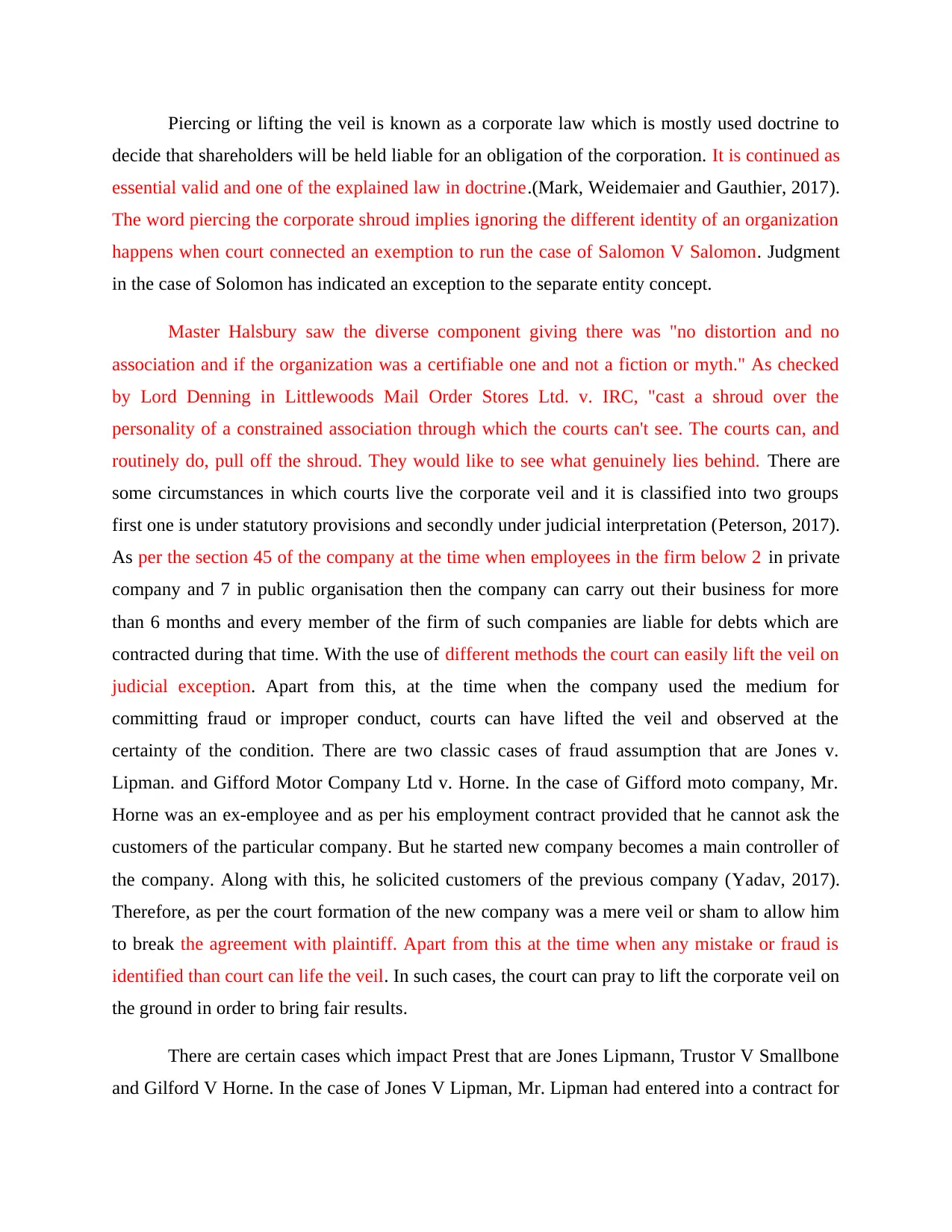
Piercing or lifting the veil is known as a corporate law which is mostly used doctrine to
decide that shareholders will be held liable for an obligation of the corporation. It is continued as
essential valid and one of the explained law in doctrine.(Mark, Weidemaier and Gauthier, 2017).
The word piercing the corporate shroud implies ignoring the different identity of an organization
happens when court connected an exemption to run the case of Salomon V Salomon. Judgment
in the case of Solomon has indicated an exception to the separate entity concept.
Master Halsbury saw the diverse component giving there was "no distortion and no
association and if the organization was a certifiable one and not a fiction or myth." As checked
by Lord Denning in Littlewoods Mail Order Stores Ltd. v. IRC, "cast a shroud over the
personality of a constrained association through which the courts can't see. The courts can, and
routinely do, pull off the shroud. They would like to see what genuinely lies behind. There are
some circumstances in which courts live the corporate veil and it is classified into two groups
first one is under statutory provisions and secondly under judicial interpretation (Peterson, 2017).
As per the section 45 of the company at the time when employees in the firm below 2 in private
company and 7 in public organisation then the company can carry out their business for more
than 6 months and every member of the firm of such companies are liable for debts which are
contracted during that time. With the use of different methods the court can easily lift the veil on
judicial exception. Apart from this, at the time when the company used the medium for
committing fraud or improper conduct, courts can have lifted the veil and observed at the
certainty of the condition. There are two classic cases of fraud assumption that are Jones v.
Lipman. and Gifford Motor Company Ltd v. Horne. In the case of Gifford moto company, Mr.
Horne was an ex-employee and as per his employment contract provided that he cannot ask the
customers of the particular company. But he started new company becomes a main controller of
the company. Along with this, he solicited customers of the previous company (Yadav, 2017).
Therefore, as per the court formation of the new company was a mere veil or sham to allow him
to break the agreement with plaintiff. Apart from this at the time when any mistake or fraud is
identified than court can life the veil. In such cases, the court can pray to lift the corporate veil on
the ground in order to bring fair results.
There are certain cases which impact Prest that are Jones Lipmann, Trustor V Smallbone
and Gilford V Horne. In the case of Jones V Lipman, Mr. Lipman had entered into a contract for
decide that shareholders will be held liable for an obligation of the corporation. It is continued as
essential valid and one of the explained law in doctrine.(Mark, Weidemaier and Gauthier, 2017).
The word piercing the corporate shroud implies ignoring the different identity of an organization
happens when court connected an exemption to run the case of Salomon V Salomon. Judgment
in the case of Solomon has indicated an exception to the separate entity concept.
Master Halsbury saw the diverse component giving there was "no distortion and no
association and if the organization was a certifiable one and not a fiction or myth." As checked
by Lord Denning in Littlewoods Mail Order Stores Ltd. v. IRC, "cast a shroud over the
personality of a constrained association through which the courts can't see. The courts can, and
routinely do, pull off the shroud. They would like to see what genuinely lies behind. There are
some circumstances in which courts live the corporate veil and it is classified into two groups
first one is under statutory provisions and secondly under judicial interpretation (Peterson, 2017).
As per the section 45 of the company at the time when employees in the firm below 2 in private
company and 7 in public organisation then the company can carry out their business for more
than 6 months and every member of the firm of such companies are liable for debts which are
contracted during that time. With the use of different methods the court can easily lift the veil on
judicial exception. Apart from this, at the time when the company used the medium for
committing fraud or improper conduct, courts can have lifted the veil and observed at the
certainty of the condition. There are two classic cases of fraud assumption that are Jones v.
Lipman. and Gifford Motor Company Ltd v. Horne. In the case of Gifford moto company, Mr.
Horne was an ex-employee and as per his employment contract provided that he cannot ask the
customers of the particular company. But he started new company becomes a main controller of
the company. Along with this, he solicited customers of the previous company (Yadav, 2017).
Therefore, as per the court formation of the new company was a mere veil or sham to allow him
to break the agreement with plaintiff. Apart from this at the time when any mistake or fraud is
identified than court can life the veil. In such cases, the court can pray to lift the corporate veil on
the ground in order to bring fair results.
There are certain cases which impact Prest that are Jones Lipmann, Trustor V Smallbone
and Gilford V Horne. In the case of Jones V Lipman, Mr. Lipman had entered into a contract for
Paraphrase This Document
Need a fresh take? Get an instant paraphrase of this document with our AI Paraphraser
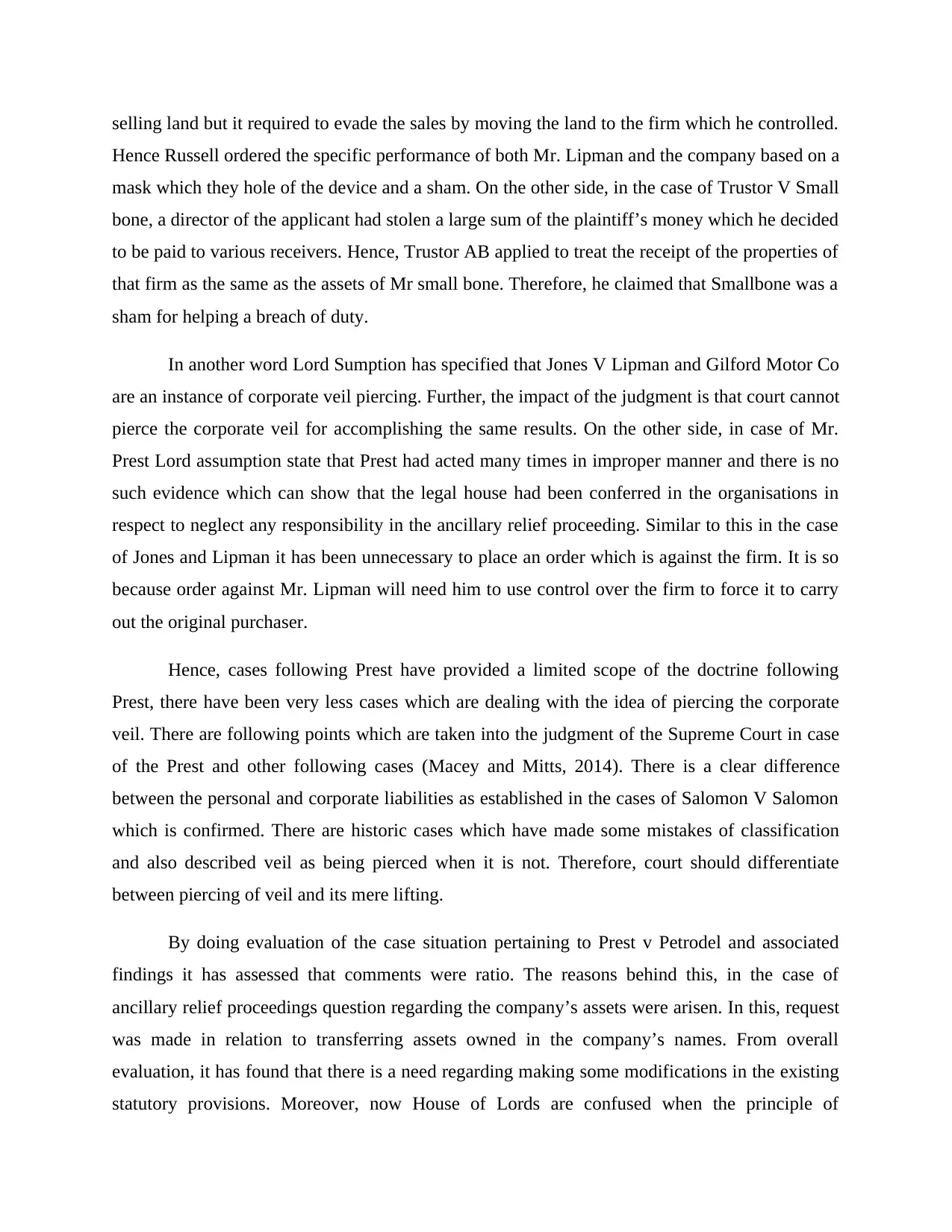
selling land but it required to evade the sales by moving the land to the firm which he controlled.
Hence Russell ordered the specific performance of both Mr. Lipman and the company based on a
mask which they hole of the device and a sham. On the other side, in the case of Trustor V Small
bone, a director of the applicant had stolen a large sum of the plaintiff’s money which he decided
to be paid to various receivers. Hence, Trustor AB applied to treat the receipt of the properties of
that firm as the same as the assets of Mr small bone. Therefore, he claimed that Smallbone was a
sham for helping a breach of duty.
In another word Lord Sumption has specified that Jones V Lipman and Gilford Motor Co
are an instance of corporate veil piercing. Further, the impact of the judgment is that court cannot
pierce the corporate veil for accomplishing the same results. On the other side, in case of Mr.
Prest Lord assumption state that Prest had acted many times in improper manner and there is no
such evidence which can show that the legal house had been conferred in the organisations in
respect to neglect any responsibility in the ancillary relief proceeding. Similar to this in the case
of Jones and Lipman it has been unnecessary to place an order which is against the firm. It is so
because order against Mr. Lipman will need him to use control over the firm to force it to carry
out the original purchaser.
Hence, cases following Prest have provided a limited scope of the doctrine following
Prest, there have been very less cases which are dealing with the idea of piercing the corporate
veil. There are following points which are taken into the judgment of the Supreme Court in case
of the Prest and other following cases (Macey and Mitts, 2014). There is a clear difference
between the personal and corporate liabilities as established in the cases of Salomon V Salomon
which is confirmed. There are historic cases which have made some mistakes of classification
and also described veil as being pierced when it is not. Therefore, court should differentiate
between piercing of veil and its mere lifting.
By doing evaluation of the case situation pertaining to Prest v Petrodel and associated
findings it has assessed that comments were ratio. The reasons behind this, in the case of
ancillary relief proceedings question regarding the company’s assets were arisen. In this, request
was made in relation to transferring assets owned in the company’s names. From overall
evaluation, it has found that there is a need regarding making some modifications in the existing
statutory provisions. Moreover, now House of Lords are confused when the principle of
Hence Russell ordered the specific performance of both Mr. Lipman and the company based on a
mask which they hole of the device and a sham. On the other side, in the case of Trustor V Small
bone, a director of the applicant had stolen a large sum of the plaintiff’s money which he decided
to be paid to various receivers. Hence, Trustor AB applied to treat the receipt of the properties of
that firm as the same as the assets of Mr small bone. Therefore, he claimed that Smallbone was a
sham for helping a breach of duty.
In another word Lord Sumption has specified that Jones V Lipman and Gilford Motor Co
are an instance of corporate veil piercing. Further, the impact of the judgment is that court cannot
pierce the corporate veil for accomplishing the same results. On the other side, in case of Mr.
Prest Lord assumption state that Prest had acted many times in improper manner and there is no
such evidence which can show that the legal house had been conferred in the organisations in
respect to neglect any responsibility in the ancillary relief proceeding. Similar to this in the case
of Jones and Lipman it has been unnecessary to place an order which is against the firm. It is so
because order against Mr. Lipman will need him to use control over the firm to force it to carry
out the original purchaser.
Hence, cases following Prest have provided a limited scope of the doctrine following
Prest, there have been very less cases which are dealing with the idea of piercing the corporate
veil. There are following points which are taken into the judgment of the Supreme Court in case
of the Prest and other following cases (Macey and Mitts, 2014). There is a clear difference
between the personal and corporate liabilities as established in the cases of Salomon V Salomon
which is confirmed. There are historic cases which have made some mistakes of classification
and also described veil as being pierced when it is not. Therefore, court should differentiate
between piercing of veil and its mere lifting.
By doing evaluation of the case situation pertaining to Prest v Petrodel and associated
findings it has assessed that comments were ratio. The reasons behind this, in the case of
ancillary relief proceedings question regarding the company’s assets were arisen. In this, request
was made in relation to transferring assets owned in the company’s names. From overall
evaluation, it has found that there is a need regarding making some modifications in the existing
statutory provisions. Moreover, now House of Lords are confused when the principle of
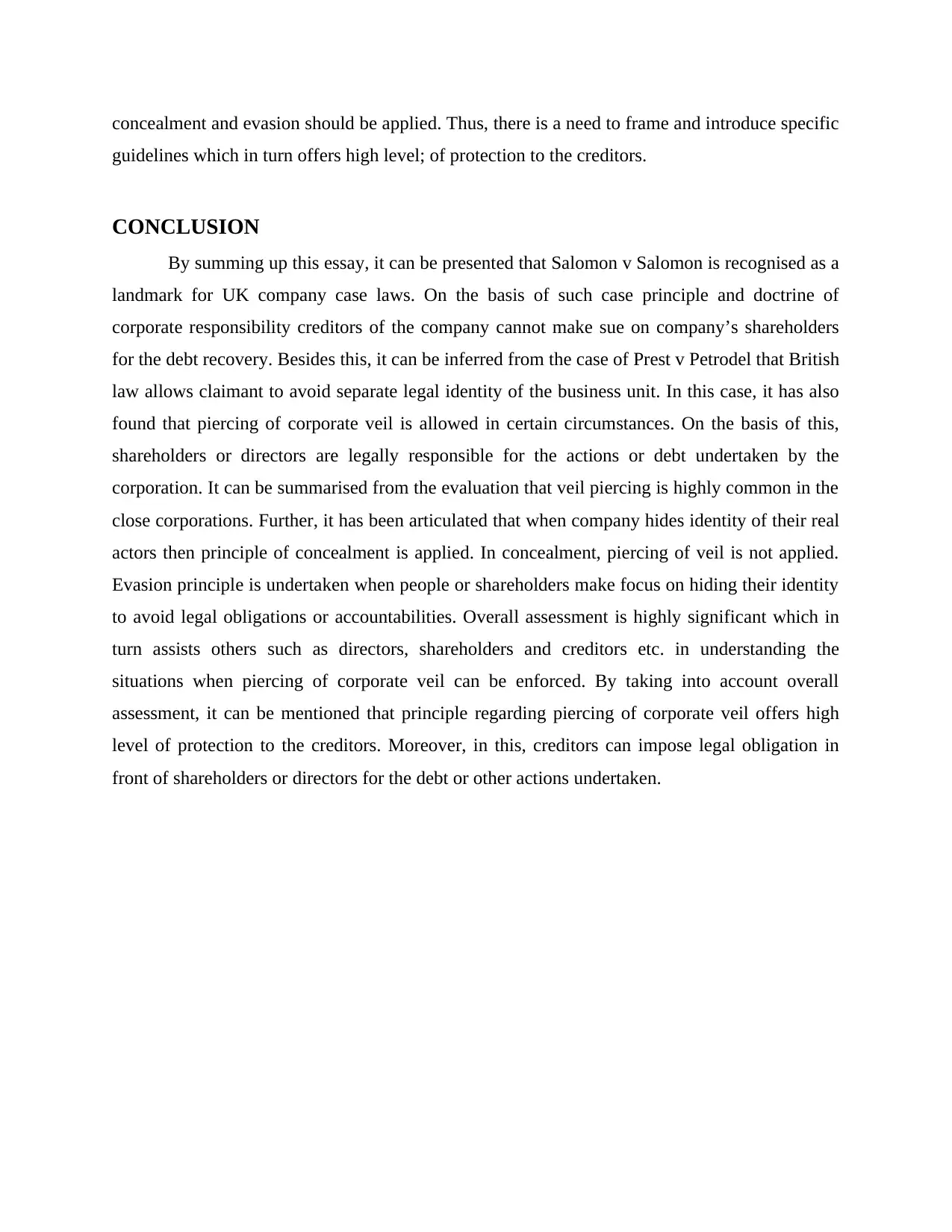
concealment and evasion should be applied. Thus, there is a need to frame and introduce specific
guidelines which in turn offers high level; of protection to the creditors.
CONCLUSION
By summing up this essay, it can be presented that Salomon v Salomon is recognised as a
landmark for UK company case laws. On the basis of such case principle and doctrine of
corporate responsibility creditors of the company cannot make sue on company’s shareholders
for the debt recovery. Besides this, it can be inferred from the case of Prest v Petrodel that British
law allows claimant to avoid separate legal identity of the business unit. In this case, it has also
found that piercing of corporate veil is allowed in certain circumstances. On the basis of this,
shareholders or directors are legally responsible for the actions or debt undertaken by the
corporation. It can be summarised from the evaluation that veil piercing is highly common in the
close corporations. Further, it has been articulated that when company hides identity of their real
actors then principle of concealment is applied. In concealment, piercing of veil is not applied.
Evasion principle is undertaken when people or shareholders make focus on hiding their identity
to avoid legal obligations or accountabilities. Overall assessment is highly significant which in
turn assists others such as directors, shareholders and creditors etc. in understanding the
situations when piercing of corporate veil can be enforced. By taking into account overall
assessment, it can be mentioned that principle regarding piercing of corporate veil offers high
level of protection to the creditors. Moreover, in this, creditors can impose legal obligation in
front of shareholders or directors for the debt or other actions undertaken.
guidelines which in turn offers high level; of protection to the creditors.
CONCLUSION
By summing up this essay, it can be presented that Salomon v Salomon is recognised as a
landmark for UK company case laws. On the basis of such case principle and doctrine of
corporate responsibility creditors of the company cannot make sue on company’s shareholders
for the debt recovery. Besides this, it can be inferred from the case of Prest v Petrodel that British
law allows claimant to avoid separate legal identity of the business unit. In this case, it has also
found that piercing of corporate veil is allowed in certain circumstances. On the basis of this,
shareholders or directors are legally responsible for the actions or debt undertaken by the
corporation. It can be summarised from the evaluation that veil piercing is highly common in the
close corporations. Further, it has been articulated that when company hides identity of their real
actors then principle of concealment is applied. In concealment, piercing of veil is not applied.
Evasion principle is undertaken when people or shareholders make focus on hiding their identity
to avoid legal obligations or accountabilities. Overall assessment is highly significant which in
turn assists others such as directors, shareholders and creditors etc. in understanding the
situations when piercing of corporate veil can be enforced. By taking into account overall
assessment, it can be mentioned that principle regarding piercing of corporate veil offers high
level of protection to the creditors. Moreover, in this, creditors can impose legal obligation in
front of shareholders or directors for the debt or other actions undertaken.
⊘ This is a preview!⊘
Do you want full access?
Subscribe today to unlock all pages.

Trusted by 1+ million students worldwide
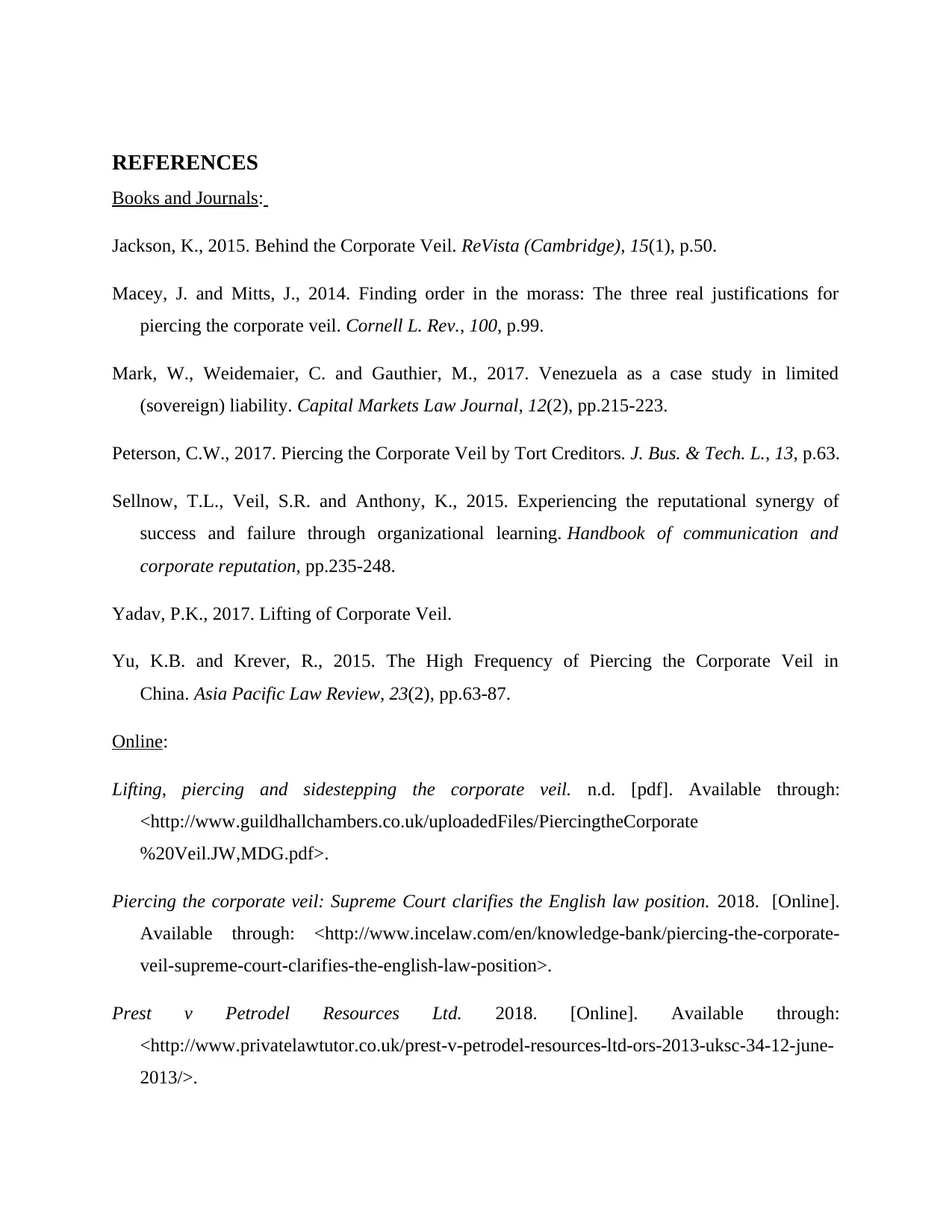
REFERENCES
Books and Journals:
Jackson, K., 2015. Behind the Corporate Veil. ReVista (Cambridge), 15(1), p.50.
Macey, J. and Mitts, J., 2014. Finding order in the morass: The three real justifications for
piercing the corporate veil. Cornell L. Rev., 100, p.99.
Mark, W., Weidemaier, C. and Gauthier, M., 2017. Venezuela as a case study in limited
(sovereign) liability. Capital Markets Law Journal, 12(2), pp.215-223.
Peterson, C.W., 2017. Piercing the Corporate Veil by Tort Creditors. J. Bus. & Tech. L., 13, p.63.
Sellnow, T.L., Veil, S.R. and Anthony, K., 2015. Experiencing the reputational synergy of
success and failure through organizational learning. Handbook of communication and
corporate reputation, pp.235-248.
Yadav, P.K., 2017. Lifting of Corporate Veil.
Yu, K.B. and Krever, R., 2015. The High Frequency of Piercing the Corporate Veil in
China. Asia Pacific Law Review, 23(2), pp.63-87.
Online:
Lifting, piercing and sidestepping the corporate veil. n.d. [pdf]. Available through:
<http://www.guildhallchambers.co.uk/uploadedFiles/PiercingtheCorporate
%20Veil.JW,MDG.pdf>.
Piercing the corporate veil: Supreme Court clarifies the English law position. 2018. [Online].
Available through: <http://www.incelaw.com/en/knowledge-bank/piercing-the-corporate-
veil-supreme-court-clarifies-the-english-law-position>.
Prest v Petrodel Resources Ltd. 2018. [Online]. Available through:
<http://www.privatelawtutor.co.uk/prest-v-petrodel-resources-ltd-ors-2013-uksc-34-12-june-
2013/>.
Books and Journals:
Jackson, K., 2015. Behind the Corporate Veil. ReVista (Cambridge), 15(1), p.50.
Macey, J. and Mitts, J., 2014. Finding order in the morass: The three real justifications for
piercing the corporate veil. Cornell L. Rev., 100, p.99.
Mark, W., Weidemaier, C. and Gauthier, M., 2017. Venezuela as a case study in limited
(sovereign) liability. Capital Markets Law Journal, 12(2), pp.215-223.
Peterson, C.W., 2017. Piercing the Corporate Veil by Tort Creditors. J. Bus. & Tech. L., 13, p.63.
Sellnow, T.L., Veil, S.R. and Anthony, K., 2015. Experiencing the reputational synergy of
success and failure through organizational learning. Handbook of communication and
corporate reputation, pp.235-248.
Yadav, P.K., 2017. Lifting of Corporate Veil.
Yu, K.B. and Krever, R., 2015. The High Frequency of Piercing the Corporate Veil in
China. Asia Pacific Law Review, 23(2), pp.63-87.
Online:
Lifting, piercing and sidestepping the corporate veil. n.d. [pdf]. Available through:
<http://www.guildhallchambers.co.uk/uploadedFiles/PiercingtheCorporate
%20Veil.JW,MDG.pdf>.
Piercing the corporate veil: Supreme Court clarifies the English law position. 2018. [Online].
Available through: <http://www.incelaw.com/en/knowledge-bank/piercing-the-corporate-
veil-supreme-court-clarifies-the-english-law-position>.
Prest v Petrodel Resources Ltd. 2018. [Online]. Available through:
<http://www.privatelawtutor.co.uk/prest-v-petrodel-resources-ltd-ors-2013-uksc-34-12-june-
2013/>.
Paraphrase This Document
Need a fresh take? Get an instant paraphrase of this document with our AI Paraphraser
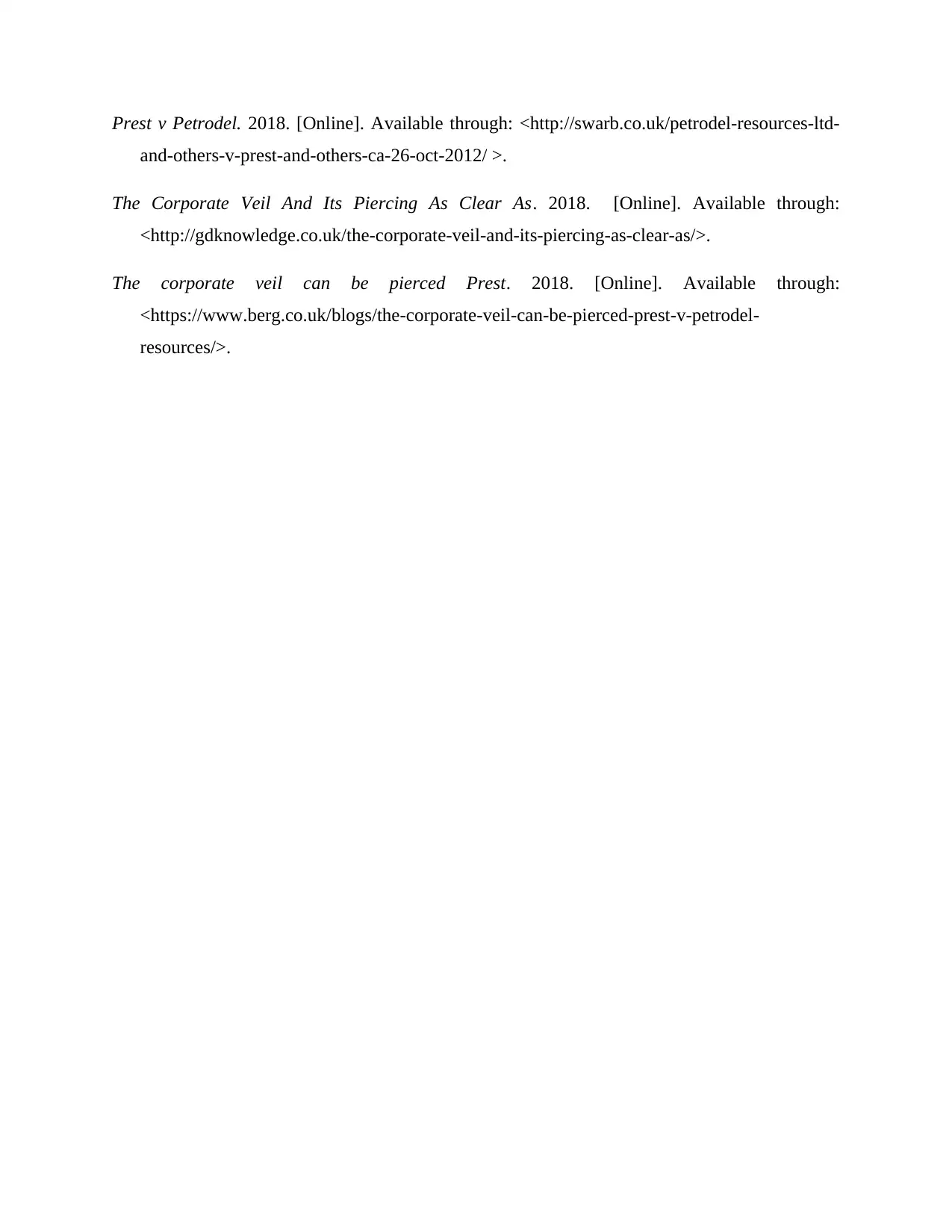
Prest v Petrodel. 2018. [Online]. Available through: <http://swarb.co.uk/petrodel-resources-ltd-
and-others-v-prest-and-others-ca-26-oct-2012/ >.
The Corporate Veil And Its Piercing As Clear As. 2018. [Online]. Available through:
<http://gdknowledge.co.uk/the-corporate-veil-and-its-piercing-as-clear-as/>.
The corporate veil can be pierced Prest. 2018. [Online]. Available through:
<https://www.berg.co.uk/blogs/the-corporate-veil-can-be-pierced-prest-v-petrodel-
resources/>.
and-others-v-prest-and-others-ca-26-oct-2012/ >.
The Corporate Veil And Its Piercing As Clear As. 2018. [Online]. Available through:
<http://gdknowledge.co.uk/the-corporate-veil-and-its-piercing-as-clear-as/>.
The corporate veil can be pierced Prest. 2018. [Online]. Available through:
<https://www.berg.co.uk/blogs/the-corporate-veil-can-be-pierced-prest-v-petrodel-
resources/>.
1 out of 11
Related Documents
Your All-in-One AI-Powered Toolkit for Academic Success.
+13062052269
info@desklib.com
Available 24*7 on WhatsApp / Email
![[object Object]](/_next/static/media/star-bottom.7253800d.svg)
Unlock your academic potential
Copyright © 2020–2025 A2Z Services. All Rights Reserved. Developed and managed by ZUCOL.





